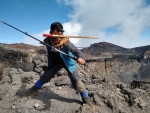Crazy Singaporean guy travels 2,300km from Okinawa to Ibaraki by scooter (Part 1)

How does one move house in Japan? This was a question I had to contend with not too long ago. I was in between jobs, about to leave Okinawa (沖縄), the place I had called home for two years, for Ibaraki (茨城), a sleepy prefecture 1 hour away from Tokyo by train.
I had gotten in touch with a moving company, who agreed to haul all my worldly possessions over to the mainland for a modest sum. All my items were packed neatly into boxes, ready for shipping. All except for one.
My 2019 Honda Super Cub

(Image credit: Ananda Kang)
This guy. My pride and joy, a 2019 Honda Super Cub. The moving company would have had no issue taking it along with the rest of my stuff for an extra nominal sum, but the adventurer in me thought differently.
“Why don’t I take my scooter aboard the ferry from Okinawa to Kyushu, and then ride it an estimated 2,000km from Kagoshima to Ibaraki? It’s going to be so much fun and I’m going to see tons of things along the way.” I saw no downside to this plan, and thus my odyssey began.

‘Moving from Okinawa to Ibaraki’. (Image credit: Ananda Kang)
I loaded up a large box and two saddlebags full of travel essentials, including 5 days’ worth of clothing and camping gear, and put out a large sign to broadcast my intent to any cars driving behind me.
Crazy Singaporean = me.
Riding the ferry from Okinawa to Kagoshima

(Image credit: Ananda Kang)
Travellers wishing to take the scenic route between Okinawa and Kagoshima (鹿児島) can opt to take this seagoing line which is serviced by two ferry companies on alternating days, A-Line and Marix. At approximately ¥14,500 one way per person, prices are fairly comparable to plane tickets, and it’s really the only option if you’re planning to take a vehicle across with you (for an additional fee). The ride lasts 25 hours and stops by several islands in the Amami-Oshima chain along the way.

(Image credit: Ananda Kang)
It was a clear and pleasant morning when I boarded the Marix ferry at the Naha Port Authority wharf, one of several port facilities in Naha. I rode my scooter up the ramp and parked it in a spacious bulkhead meant for vehicles, alongside several other cars. Two service staff helped secure it tightly with ratchet straps.

(Image credit: Ananda Kang)
The craft itself was huge, with a cavernous space for holding vehicles, a vast upper deck where passengers can step out for some fresh air and admire the ocean view, as well as plenty of amenities to tide over the journey.

(Image credit: Ananda Kang)
Though somewhat dated, it was equipped with vending machines, showers, and even a modest restaurant that could be used freely outside mealtimes. A variety of accommodation types were available, such as deluxe suites and bunk beds, but I went for the cheapest option—a simple mat, pillow and blanket laid on the floor of a large room shared with many others.

(Image credit: Ananda Kang)
Much of my time aboard was spent sleeping and snapping occasional photos of passing islands from the upper deck. The mostly uneventful trip was punctuated with flurries of activity every time we called to port along the way. I had fun observing stevedores and forklift operators at work while staring out over the tropical islandscapes I was certain I wasn’t going to see again anytime soon.
Mainland, Ho!

(Image credit: Ananda Kang)
The next morning arrived, and with it came my first glimpse of the mainland from the mouth of Kagoshima Bay. Mount Kaimon (開門岳 Kaimondake) is a beautiful near-perfectly conical dormant volcano, one of the 100 Famous Japanese Mountains, and has long been known amongst several Mount Fuji lookalikes all over the country as ‘Satsuma Fuji’. If you want to reach it by train, get off at Yamakawa Station from Ibusuki and proceed to Kaimon Sanroku Fureai Park (かいもん山麓ふれあい公園 Kaimon-sanrokufureai Koen).

(Image credit: Ananda Kang)
We passed through into the bay, and soon enough Kagoshima City pulled into view. My attention was immediately diverted to Kagoshima’s most ostentatious feature, Sakurajima (桜島). An ever-looming presence over the city with a storied history of eruptions over the centuries, it can be seen from multiple places all over the city.

“Oi you, why aren’t you wearing a mask?” (Image credit: Ananda Kang)
I dived right into the heart of Kagoshima, a shopping arcade called Chuo-Dori (中央通). Here, even the statues are observing proper mask etiquette.

(Image credit: Ananda Kang)
One of the many specialities of Kagoshima is Tontoro Ramen (豚トロラーメン), noodles in a savoury umami broth topped off with generous chunks of pork cheek. I enjoyed this sumptuous meal at Mengarufu Tenmonkan, located a few minutes away from Tenmonkandori Tram Station (天文館通駅), reachable from Kagoshima-Chuo Station (鹿児島中央駅).

(Image credit: Ananda Kang)
My appetite sated, it was time for my journey to begin in earnest. With Sakurajima in the background wishing me well, I rode off and crossed the city limits of Kagoshima, bright-eyed and excited to uncover what more beautiful sights lay before me in the days to come…
Naha Port Authority
Address: 2-1 Tondocho, Naha-shi, Okinawa, 900-0035
Nearest station: Asahibashi Station (旭橋駅)
Opening hours: 6am–11pm
TEL: +81 98-868-2578
Mengarufu Tenmonkan (鹿児島ラーメン 我流風 天文館本店)
Address: 14-3, Ocherville 1F, Higashisengokucho, Kagoshima-shi, Kagoshima, 892-0842
Nearest station: Kagoshima-Chuo Station (鹿児島中央駅)
Nearest tram station: Tenmonkandori Station (天文館通駅)
Opening hours: 11am–11:30pm (Mon–Sat), 11am–9pm (Sun)
TEL: +81 99-227-7588
Header image credit: Ananda Kang





